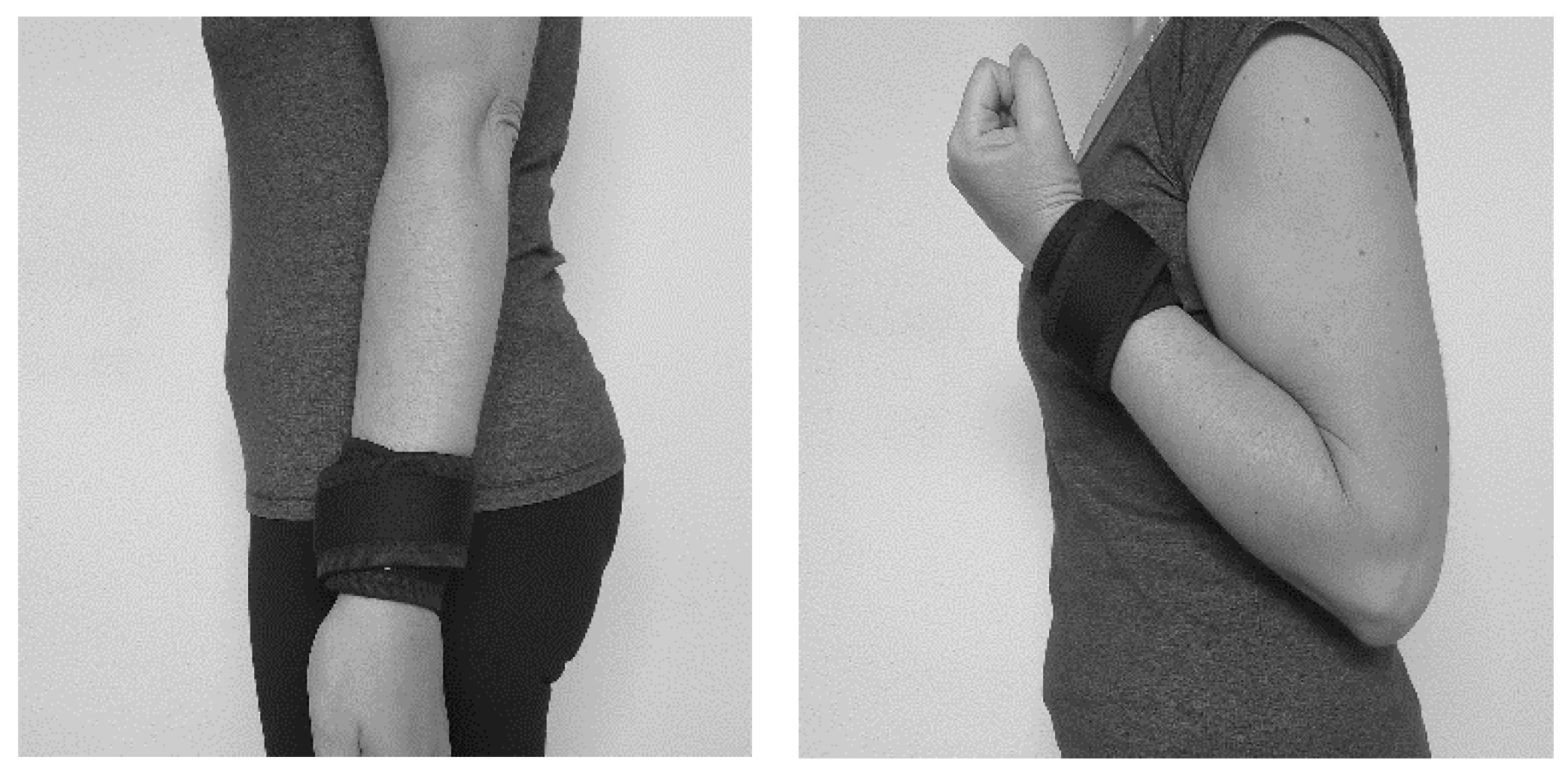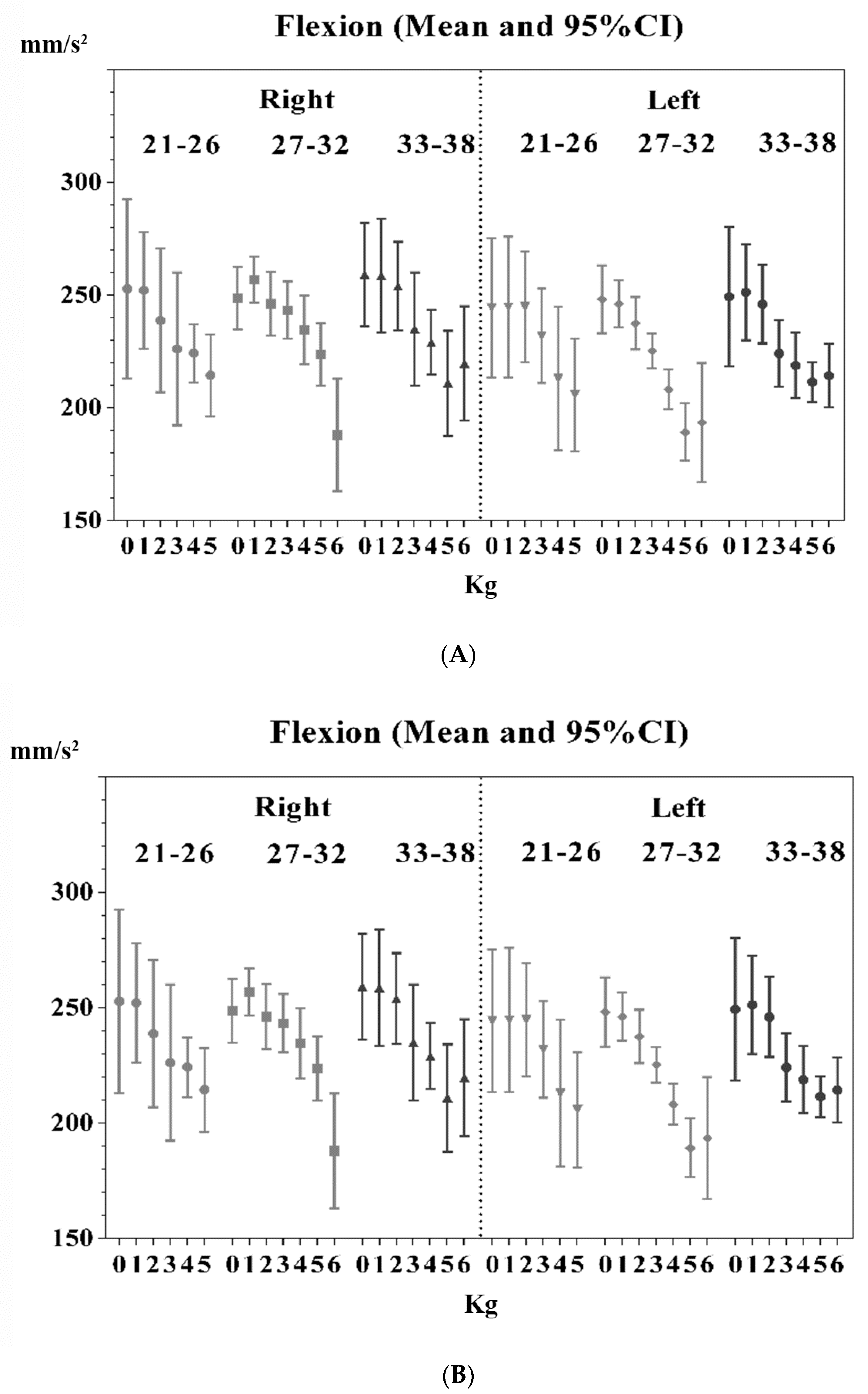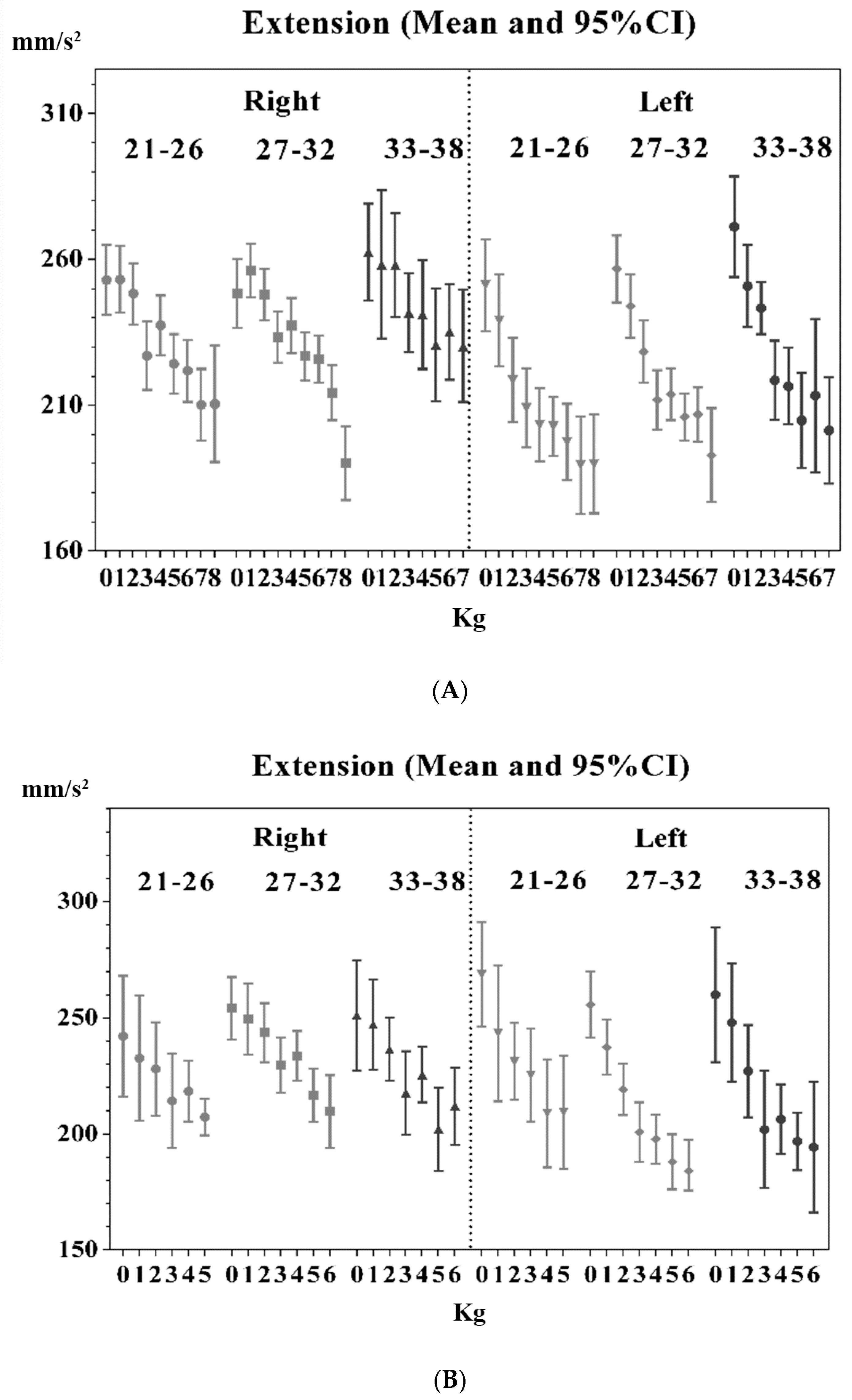Protocol of Action in Injuries of the Long Head of the Biceps Tendon. Joint Reference Values and Recommended Training Weight for the Recovery of Joint Range and Strength
Abstract
:1. Introduction
2. Materials and Methods
2.1. Subjects
2.2. Measurement Instrument
2.3. Procedure
2.4. Statistical Analysis
3. Results
4. Discussion
4.1. Range of Motion of the Elbow Joint
4.2. Strength and Speed of Movement Execution
5. Conclusions
Funding
Institutional Review Board Statement
Informed Consent Statement
Acknowledgments
Conflicts of Interest
References
- Zaremski, J.L.; Galloza, J.; Sepulveda, F.; Vasilopoulos, T.; Micheo, W.; Herman, D.C. Recurrence and return to play after shoulder instability events in young and adolescent athletes: A systematic review and meta-analysis. Br. J. Sports Med. 2017, 51, 177–184. [Google Scholar] [CrossRef]
- Vicente-Pardo, J.M. Hombro doloroso e incapacidad temporal. El retorno al trabajo tras larga baja por hombro doloroso. Causalidad del trabajo en el hombro doloroso. Med. Segur. Trab. 2016, 62, 337–359. [Google Scholar]
- Ge, H.; Zhang, Q.; Sun, Y.; Li, J.; Sun, L.; Cheng, B. Tenotomy or tenodesis for the long head of biceps lesions in shoulders: A systematic review and meta-analysis. PLoS ONE 2015, 10, e0121286. [Google Scholar] [CrossRef] [Green Version]
- Khazzam, M.; George, M.S.; Churchill, R.S.; Kuhn, J.E. Disorders of the long head of biceps tendón. J. Shoulder Elb. Surg. 2012, 21, 136–145. [Google Scholar] [CrossRef]
- Urita, A.; Funakoshi, T.; Amano, T.; Matsui, Y.; Kawamura, D.; Kameda, Y.; Iwasaki, N. Predictive factors of long head of the biceps tendon disorders-the bicipital groove morphology and subscapularis tendon tear. J. Shoulder Elb. Surg. 2016, 25, 384–389. [Google Scholar] [CrossRef]
- Refior, H.J.; Sowa, D. Long tendon of the biceps brachii: Sites of predilection for degenerative lesions. J. Shoulder Elb. Surg. 1995, 4, 436–440. [Google Scholar] [CrossRef]
- Abrams, G.D.; Safran, M.R. Diagnosis and management of superior labrum anterior posterior lesions in overhead athletes. Br. J. Sports Med. 2010, 44, 311–318. [Google Scholar] [CrossRef]
- Pinto-Carral, A.; Fernández Villa, T.; Molina de la Torre, A. Patient reported mobility: A systematic review. Arch. Phys. Med. Rehabil. 2016, 97, 1182–1194. [Google Scholar] [CrossRef] [PubMed]
- Schultz, J. Clinical evaluation of the shoulder. Phys. Med. Rehabil. Clin. N. Am. 2004, 15, 351–371. [Google Scholar] [CrossRef] [PubMed]
- Hsu, A.R.; Ghodadra, N.S.; Provencher, C.M.T.; Lewis, P.B.; Bach, B.R. Biceps tenotomy versus tenodesis: A review of clinical outcomes and biomechanical results. J. Shoulder Elb. Surg. 2011, 20, 326–332. [Google Scholar] [CrossRef]
- Frost, A.; Zafar, M.S.; Maffulli, N. Tenotomy versus tenodesis in themanagement of pathologic lesions of the tendón of the long head of the biceps brachii. Am. J. Sports Med. 2009, 37, 828–833. [Google Scholar] [CrossRef] [PubMed]
- Friedman, J.L.; FitzPatrick, J.L.; Rylander, L.S.; Bennett, C.; Vidal, A.F.; McCarty, E.C. Biceps tenotomy versus tenodesis in active patients younger than 55 years is there a difference in strength and outcomes? Orthop. J. Sports Med. 2015, 3, 1–6. [Google Scholar] [CrossRef] [PubMed]
- Morrey, B.F.; Askew, L.J.; Chao, E.Y. A biomechanical study of normal functional elbow motion. J. Bone Jt. Surg. Am. 1981, 63, 872–877. [Google Scholar] [CrossRef]
- Barad, J.H.K.; Rachel, S.; Ebramzadeh ESilva, M. Range of motion of the healthy pediatric elbow. J. Pediatr. Orthop. 2013, 22, 117–122. [Google Scholar] [CrossRef]
- Schreiner, A.J.; Schweikardt, N.; Gühring, D.; Ahrend, M.D.; Döbele, S.; Ahmad, S.S.; Baumann, M.; Hirschmann, M.T.; Bozzi, F.; Ateschrang, A. Arthroscopic arthrolysis leads to improved range of motion and health-related quality of life in post-traumatic elbow stiffness. J Shoulder Elbow Surg. 2020, 29, 1538–1547. [Google Scholar] [CrossRef] [PubMed]
- Sardelli, M.; Tashjian, R.Z.; MacWilliams, B.A. Functional elbow range of motion for contemporary tasks. J. Bone Jt. Surg. Am. 2011, 93, 471–477. [Google Scholar] [CrossRef]
- Wilps, T.; Kaufmann, R.A.; Yamakawa, S.; Fowler, J.R. Elbow Biomechanics: Bony and Dynamic Stabilizers. J. Hand Surg. Am. 2020, 45, 528–535. [Google Scholar] [CrossRef] [PubMed]
- Ahmed Sheha, S.M.; Rasmy Elserougy, H.; Gaid Esdhom, M. Difference in Isokinetic Strength of Shoulder Joint Muscles in Dominant versus Nondominant Upper Extremities in Children. J. Nurs. Health Sci. 2019, 8, 32–36. [Google Scholar]
- Pérez-de la Cruz, S.; de León, Ó.A.; Mallada, N.P.; Rodríguez, A.V. Validity and intra-examiner reliability of the Hawk goniometer versus the universal goniometer for the measurement of range of motion of the glenohumeral joint. Med. Eng. Phys. 2021, 89, 7–11. [Google Scholar] [CrossRef]
- Güleçyüz, M.F.; Pietschmann, M.F.; Michalski, S.; Eberhard, F.M.; Crispin, A.; Schröder, C.; Mittermüller, M.J.; Müller, P.E. Reference Values of Flexion and Supination in the Elbow Joint of a Cohort without Shoulder Pathologies. BioMed Res. Int. 2017, 2017, 1654796. [Google Scholar] [CrossRef] [Green Version]
- O’Sullivan, L.W.; Gallwey, T.J. Upper-limb surface electromyography at maximum supination and pronation torques: The effect of elbow and forearm angle. J. Electromyogr. Kinesiol. 2002, 12, 275–285. [Google Scholar] [CrossRef] [Green Version]
- Chapleau, J.; Canet, F.; Petit, Y.; Sandman, E.; Laflamme, G.-Y.; Rouleau, D.M. Demographic and anthropometric factors affecting elbow range of motion in healthy adults. J. Shoulder Elb. Surg. 2013, 22, 88–93. [Google Scholar] [CrossRef]
- Valone, L.C.; Cameron, W.; Tartarilla, A.B.; Whited, A.; Sugimoto, D.; Bae, D.S.; Bauer, A.S. Functional Elbow Range of Motion in Children and Adolescents. J. Pediatr. Orthop. 2020, 40, 304–309. [Google Scholar] [CrossRef]
- Borsa, P.A.; Laudner, K.G.; Sauers, E.L. Mobility and stability adaptations in the shoulder of the overhead athlete. Sports Med. 2008, 38, 17–36. [Google Scholar] [CrossRef] [PubMed]
- Carter, A.B.; Kaminski, T.W.; Douex, A.T.; Knight, C.A.; Richards, J.G. Effects of highvolume upper extremity plyometric training on throwing velocity and functional strength ratios of the shoulder rotators in collegiate baseball players. J. Strength Cond. Res. 2007, 21, 208–215. [Google Scholar] [CrossRef]
- Byram, I.; Bushnell, B.; Dugger, K.; Charron, K.; Harrell, F.J.; Noonan, T. Preseason shoulder strength measurements in professional baseball pitchers: Identifying players at risk for injury. Am. J. Sports Med. 2010, 38, 1375–1382. [Google Scholar] [CrossRef] [PubMed]
- Jayanthi, N.; Pinkham, C.; Dugas, L.; Patrick, B.; Labella, C. Sports specialization in young athletes: Evidence-based recommendations. Sports Health 2013, 5, 251–257. [Google Scholar] [CrossRef] [PubMed] [Green Version]
- Shank, J.R.; Singleton, S.B.; Braun, S.; Kissenberth, M.J.; Ramappa, A.; Ellis, H.; Torry, M.R. A comparison of forearm supination and elbow flexion strength in patients with long head of the biceps tenotomy or tenodesis. J. Arthrosc. Relat. Surg. 2011, 27, 9–16. [Google Scholar] [CrossRef]
- Ellenbecker, T.S.; Davies, G.J. The application of isokinetics in testing and rehabilitation of the shoulder complex. J. Athl. Train. 2000, 35, 338–350. [Google Scholar]
- Mayer, F.; Horstmann, T.; Bäurle, W.; Grau, S.; Handel, M.; Dickhuth, H.H. Diagnostics with isokinetic devices in shoulder measurements potentials and limits. Isokinet. Exerc. Sci. 2001, 9, 19–25. [Google Scholar] [CrossRef]
- Trakis, J.E.; McHugh, M.P.; Caracciolo, P.A.; Busciacco, L.; Mullaney, M.; Nicholas, S.J. Muscle strength and range of motion in adolescent pitchers with throwing-related pain: Implications for injury prevention. Am. J. Sports Med. 2008, 36, 2173–2178. [Google Scholar] [CrossRef] [PubMed]
- Maly, T.; Zahalka, F.; Mala, L.; Cech, P. The bilateral strength and power asymmetries in untrained boys. Open Med. 2015, 10, 224–232. [Google Scholar] [CrossRef] [PubMed]
- Yoshizaki, K.; Hamada, J.; Tamai, K.; Sahara, R.; Fujiwara, T.; Fujimoto, T. Analysis of the scapulohumeral rhythm and electromyography of the shoulder muscles during elevation and lowering: Comparison of dominant and nondominant shoulders. J. Shoulder Elbow. Surg. 2009, 18, 756–763. [Google Scholar] [CrossRef] [PubMed]




| Min–Max | Mean ± SD | Women (Mean ± SD)/Men (Mean ± SD) | |
|---|---|---|---|
| Age | 21–38 | 28.92 ± 2.7 | 29.62± 2.47/32.63 ±4.91 |
| Height (cm) | 162–194 | 175.26 ± 5.61 | 170.28 ± 4.60/174.33 ± 2.78 |
| Weight (kg) | 52–93 | 74.19 ± 8.11 | 68.46 ± 6.01/77.81 ± 5.05 |
| Physical activity (hours/week) | 4–18 | 7.83 ±1.94 | 6.79 ± 0.49/9.25 ± 1.16 |
| BMI | 18.2–29.2 | 23.45 ± 3.19 | 21.33 ± 2.08/26.28 ± 3.04 |
| ROM Right Arm | Total Mean (DT) | Gender, Mean (SD) | |
| Female | Male | ||
| ROM_0 kg | 116.8–162.26 | 116.8–162.26 | 116.8–157.07 |
| ROM_1 kg | 117.27–157.4 | 120.85–156.32 | 117.27–157.4 |
| ROM_2 kg | 106.18–159.39 | 116.5–159.33 | 106.18–159.39 |
| ROM_3 kg | 100.93–167.05 | 119.26–157.01 | 100.93–167.05 |
| ROM_4 kg | 102.06–164.14 | 114.37–152.97 | 102.06–164.14 |
| ROM_5 kg | 99.5–157.25 | 113.16–153.37 | 99.5–157.25 |
| ROM_6 kg | 103.29–150.59 | 111.12–147.87 | 103.29–150.59 |
| ROM_7 kg | 103.71–155.73 | 126.5–153.54 | 103.71–155.73 |
| ROM_8 kg | 99.13–140.72 | - | 99.13–140.72 |
| ROM Left Arm | Total Mean (DT) | Gender, Mean (SD) | |
| Female | Male | ||
| ROM_0 kg | 104.74–161.89 | 118.22–159.87 | 104.74–161.89 |
| ROM_1 kg | 115.19–160.6 | 124.91–160.14 | 115.19–160.6 |
| ROM_2 kg | 112.39–162.1 | 112.39–160.13 | 112.39–162.1 |
| ROM_3 kg | 98.8–159.09 | 98.8–156 | 98.8–159.09 |
| ROM_4 kg | 94.32–155.8 | 94.32–155.43 | 94.32–155.8 |
| ROM_5 kg | 100.77–152.08 | 107.94–149.01 | 100.77–152.08 |
| ROM_6 kg | 102.82–158.02 | 105.46–144.47 | 102.82–158.02 |
| ROM_7 kg | 98.09–152.27 | 138.11–152.27 | 98.09–152.27 |
| ROM_8 kg | 113.26–118.15 | - | 113.26–118.15 |
Publisher’s Note: MDPI stays neutral with regard to jurisdictional claims in published maps and institutional affiliations. |
© 2021 by the author. Licensee MDPI, Basel, Switzerland. This article is an open access article distributed under the terms and conditions of the Creative Commons Attribution (CC BY) license (https://creativecommons.org/licenses/by/4.0/).
Share and Cite
Pérez-de la Cruz, S. Protocol of Action in Injuries of the Long Head of the Biceps Tendon. Joint Reference Values and Recommended Training Weight for the Recovery of Joint Range and Strength. Appl. Sci. 2021, 11, 10382. https://doi.org/10.3390/app112110382
Pérez-de la Cruz S. Protocol of Action in Injuries of the Long Head of the Biceps Tendon. Joint Reference Values and Recommended Training Weight for the Recovery of Joint Range and Strength. Applied Sciences. 2021; 11(21):10382. https://doi.org/10.3390/app112110382
Chicago/Turabian StylePérez-de la Cruz, Sagrario. 2021. "Protocol of Action in Injuries of the Long Head of the Biceps Tendon. Joint Reference Values and Recommended Training Weight for the Recovery of Joint Range and Strength" Applied Sciences 11, no. 21: 10382. https://doi.org/10.3390/app112110382






